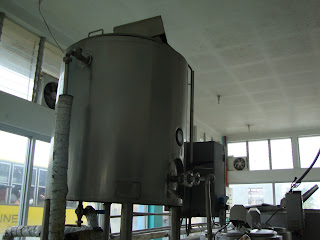The Le Grande Dairy Production Plant produces milk, both flavored and fresh.
Flavors: Chocolate, Fresh (White), Mango, Pandan, Ube
Prices: P7 per milk bar containing 100mL of milk, P10 per milk powder in a sachet that will make 200mL of milk, P25 per bottle that contains 330mL, P35 per bottle that contains 500mL
Ingredients: Milk, Sugar, Water and Flavoring
Steps:
1. Milk is gathered from the cows using the milking machine.
2. Storage tanks are used to keep milk that has just been delivered from the milking station.
3. Milk is poured into the cooling tank.
4. The pasteurizing tanks heats the milk to 72C in order to kill harmful particles such as bacteria.
5. The homogenizer smoothens the milk by turning solid milk particles into liquid through the use of pressure and heat.
6. After homogenizing, the milk is poured into the holding tanks which cools the milk to 2C to 4C.
7. Milk is packaged and placed in the cold storage room to prevent the products from spoiling.
























